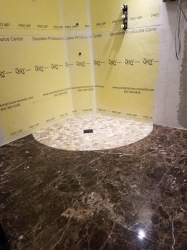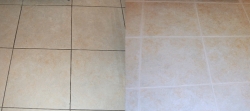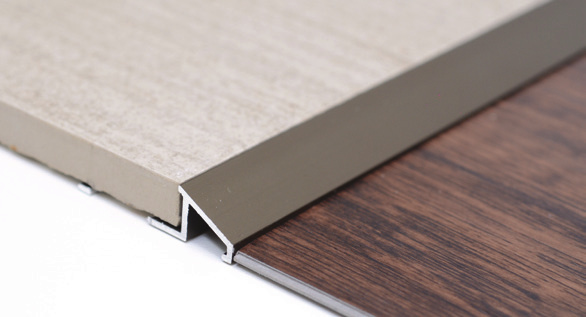Schluter RENO-U Tile Edge Protection / Floor Transition Profiles

Schluter RENO-U Tile Edge Protection / Floor Transition Profiles
- Designed to provide a smooth transition from tile coverings to floor coverings at lower elevations.
- 2.5 m (8' 2-1/2") Length; 3.5 mm-20 mm (1/8"-3/4") Heights are available
- Available in Stainless steel, solid brass and Anodized Aluminum.
Consider an alternative product
Schluter RENO-U Tile Edge Protection / Floor Transition Profiles
Application and Function

Schluter-RENO-U is designed to provide a smooth transition between tile coverings and floor coverings at lower elevations or finished concrete.
The profile is available in stainless steel, solid brass, anodized aluminum and Tuscan color-coated aluminum. Schluter-RENO-U features a trapezoid-perforated anchoring leg, which is secured in the mortar bond coat beneath the tile, and a sloped surface (approximately 25) that eliminates trip hazards and protects tile edges.
The leading edge of the profile abuts the lower surface covering, typically VCT. Schluter-RENO-U, in solid brass, and anodized aluminum features an integrated joint spacer that establishes a defined joint cavity between the tile and the profile. Schluter-RENO-U, in stainless steel, is roll-formed and does not feature an integrated joint spacer.
In installations where the leading edge abuts a lower surface covering, all sizes of Schluter-RENO-U, except the 3/4" (20 mm) and 11/16" (17.5 mm), are compliant with the Americans with Disabilities Act (ADA).
In installations where the leading edge rests on top of the lower floor covering, the 3/4" (20 mm), 11/16" (17.5 mm), and 9/16" (15 mm) sizes are not ADA compliant.
Available Sizes and Materials
Material H = Tile Thickness 5/16" - 8 mm 3/8" - 10 mm 1/2" - 12.5 mm 9/16" - 15 mm 11/16" - 17.5 mm 3/4" - 20 mm Item Number Stainless Steel 304 (1.4301 = V2A) (E) EU80 EU100 EU125 EU150 EU175 EU200 Brushed stainless Steel 304 (1.4301 = V2A) (EB) EBU80 EBU100 EBU125 EBU150 EBU175 EBU200 Solid brass (M) MU80 MU100 MU125 MU150 MU175 MU200 Satin anodized aluminum (AE) AEU80 AEU100 AEU125 AEU150 AEU175 - Bright chrome anodized aluminum (ACB) AU80ACB AU100ACB AU125ACB - - - Satin nickel anodized aluminum (AT) AU80AT AU100AT AU125AT - - - Brushed nickel anodized aluminum (ATGB) AU80ATGB AU100ATGB AU125ATGB - - - Satin copper/bronze anodized aluminum (AK) AU80AK AU100AK AU125AK - - - Brushed copper/bronze anodized aluminum (AKGB) AU80AKGB AU100AKGB AU125AKGB - - - Brushed antique bronze anodized aluminum (ABGB) AU80ABGB AU100ABGB AU125ABGB - - - Satin brass anodized aluminum (AM) AU80AM AU100AM AU125AM - - - Bright brass anodized aluminum (AMB) AU80AMB AU100AMB AU125AMB - - - Installation
Schluter RENO-U Installation
- Select Schluter-RENO-U according to tile thickness. Fill the cavity beneath the sloped section of the profile with thin-set mortar.
- Using a notched trowel, apply thin-set mortar to the area where the profile is to be placed.
- Press the perforated anchoring leg of the profile into the mortar and align.
- Trowel additional thin-set mortar over the perforated anchoring leg to ensure full coverage and support of the tile edges.
- Solidly embed the tiles so that the tiled surface is flush with the top of the profile; the profile should not be higher than the tiled surface, but rather up to approximately 1/32" (1 mm) lower.
- For solid brass or aluminum, set the tile to the integrated joint spacer, which ensures a uniform joint of 1/16 1/8 (1.5 3 mm). For stainless steel, leave a space of approximately 1/16" - 1/8" (1.5 - 3 mm) between the tile and the profile.
- Fill the joint completely with grout or setting material.
- Work with materials and tools that will not scratch or damage sensitive surfaces. Setting materials and grouts must be removed immediately, especially from anodized aluminum surfaces.
Material
Schluter-RENO-U is available in stainless steel, solid brass, and anodized aluminum.
In special cases, the suitability of a proposed type of material must be verified based on the anticipated chemical, mechanical, and/or other stresses.
Schluter-RENO-U, in stainless steel, is roll-formed using 304 (1.4301 = V2A) stainless steel. Therefore, the profiles contour differs slightly from those made of extruded brass or aluminum. The profile can sustain high mechanical stresses and is especially well suited for applications requiring resistance against chemicals and acids; for example, in the food industry, breweries, dairies, commercial kitchens, public swimming pools, and hospitals.
Schluter-RENO-U, in solid brass, is capable of withstanding high mechanical stresses and is resistant to most chemicals encountered in tiled environments. Solid brass that is exposed to air will oxidize, resulting in a natural patina. If exposed to moisture or aggressive substances, heavy oxidation and spotting may occur.
Schluter-RENO-U, in anodized aluminum, must be tested to verify its suitability if chemical exposure is expected. Cementitious materials, in conjunction with moisture, become alkaline. Since aluminum is sensitive to alkaline substances, exposure to the alkali (depending on the concentration and duration of exposure) may result in corrosion (aluminum hydroxide formation). Therefore, it is important to remove mortar or grout residue from visible surfaces. In addition, ensure that the profile is solidly embedded in the setting material and that all cavities are filled to prevent the collection of alkaline water. The anodized surface layer retains a uniform appearance during normal use, but must be protected against abrasion.
Maintenance
Schluter-RENO-U requires no special maintenance and is resistant to mold and fungi. Clean profile using common household cleaning agents.
Stainless steel surfaces exposed to the environment or aggressive substances should be cleaned periodically using a mild household cleaner. Regular cleaning maintains the neat appearance of stainless steel and reduces the risk of corrosion. All cleaning agents must be free of hydrochloric and hydrofluoric acid. Stainless steel surfaces develop a sheen when treated with a chrome-polishing agent.
Oxidation films on exposed solid brass can be removed by using a conventional polishing agent, but will form again.
In the case of anodized aluminum and tuscan color-coated aluminum do not use abrasive cleaning agents. Damage to the anodized layer can be repaired by applying varnish.
Customer Reviews and Ratings
No reviews yet! Be the first to review this product.
Product Shipping Information
You will be able to estimate shipping amount to your specific destination for your entire cart during the checkout process.
General shipping InformationKeywords: reducer, floor, edge, protection, decoration, transition, finishing, tile, carpet, stairs, schluter, reno, steel, stainless, aluminum, solid, brass, anodized, satin, chrome, nickel, copper, bronze, bright, flooring trim - underlayment, tile edge profiles, edge protection and transition, schluter systems, Schluter, Protection, Floor, Transition, Profiles, Designed, provide, smooth, coverings, lower, elevations, Length, Heights, available, Available, Stainless, Anodized, Aluminum
Description: Schluter RENO-U Tile Edge Protection / Floor Transition Profiles. Designed to provide a smooth transition from tile coverings to floor coverings at lower elevations. 2.5 m (8' 2-1/2") Length; 3.5 mm-20 mm (1/8"-3/4") Heights are available. Available in Stainless steel, solid brass and Anodized Aluminum.
Categories: Tile Edge Profiles > Edge Protection and Transition
Google Category: Hardware > Flooring > Stone Flooring > Tile Flooring
SKU(s): 153568, 153569, 153570, 153571, 153572, 153573, 153574, 153575, 153576, 153577, 153578, 153579, 153580, 153581, 153582, 153583, 153584, 153585, 153586, 153587, 153588, 153589, 153590, 153592, 153593, 153594, 153595, 153596, 153597, 153598, 153599, 153600, 153601, 153602, 153603, 153604, 153605, 153606, 153607, 153608, 153609, 153610, 153611, 153612, 153613, 153614, 153615
MPN(s): AEU100, AEU125, AEU150, AEU175, AEU80, AU100ABGB, AU100ACB, AU100AK, AU100AKGB, AU100AM, AU100AMB, AU100AT, AU100ATGB, AU125ABGB, AU125ACB, AU125AK, AU125AKGB, AU125AM, AU125AMB, AU125AT, AU125ATGB, AU80ABGB, AU80ACB, AU80AK, AU80AKGB, AU80AM, AU80AMB, AU80AT, AU80ATGB, EBU100, EBU125, EBU150, EBU175, EBU200, EBU80, EU100, EU125, EU150, EU175, EU200, EU80, MU100, MU125, MU150, MU175, MU200, MU80













